Saussez amply showed the priest was working to a plan
Saussez has amply shown the priest was working to a plan. In his CD and conference he gave on the Tomb of the Lords1 he wrote:
"When the bell-ringer, during the renovations [of the church], saw something glinting on top of/or inside an old baluster2 that the masons had discarded...it turned out to be a glass phial3 - & inside this glass phial was a parchment. This parchment allowed Saunière to find the crypt of the Tomb of the Lords & other information too. This find takes place in around 18874. After this discovery, Saunière carries out some activities which most certainly is suggestive of him searching for something.
• Beginning in 18915 Saunière approaches the town council to close off the square in front of the church and cemetery.
• He wants to build religious furniture and lay flower-beds here (however he doesn’t do this til 1894 -1897).
•The Council agrees to his request after public consultation.
• Saunière then appropriates 500m2 of space in front of the church and cemetery. He controls access to this area for 300 days of the year6. Why? To excavate? Saunière certainly excavates here and in the cemetery7.
• Saunière moves the worship of the Virgin Mary to outside the church. Originally however this was inside the church, & there was an altar to the Virgin not far from the place of the original pulpit. This was referred to by Leuillieux in 1876.
• There are concealed recesses here (Saunière built these). The staircase built here matches the exact size of the original altar of the Virgin (58cm x 200cm)8
• The accounts of the lifting of this altar Saussez thinks is the root of the eyewitness descriptions (‘I saw a pot with shiny glinty objects ..’) of the workers with Saunière when they raised the slab. They saw the glinting objects under the stone slab when it was removed. Saunière says to his workers these are worthless medallions from Lourdes, cementing the connection with the Virgin altar9.
• The stone slab raised at this altar marked an entrance passage. Saunière puts temporary floorboards down here. At the opposite end of the church he builds the Secret Room10. Steps down from this second entry passage are later found by Cholet.[courtesy Paul Saussez]
Some 'disbelievers' argue that the story of the parchment found in the glass phial is not legitimate because it appears late and is not contemporary with Saunière. For example, Saunière didn't write in his diary 'found a parchment' etc. Some 'disbelievers' also think Corbu invented the whole idea. However, the 'story' of something being found in glass phial comes via family history and stories passed down the family, i.e from oral history. As long as the appropriate caveats are used there is no reason to doubt the recollections and family traditions. Village communities are renowned for gossip and knowing everyone else's business. Why is their testimony not acceptable?
Furthermore Saunière continued with a planned stratagem:
• There was already an entrance on the south side of the Church wall. It was the private entrance used by the Lords of Rennes. It was called the ‘Gate of the Lords’11
• Eyewitness accounts of a phial seen in an old baluster had an old parchment in it. This baluster was an architectural feature holding up two arches at the side of the church.
• this paper most certainly the work of Bigou. Revealed the Tomb of the Lords12?
• Parish register found among the papers of the late Saunière which referred to this Tomb of the Lords.
• Discovery of a tomb on 21/9/189113 - does it relate to this Tomb of the Lords? [The discovery seems to culminate at the end of all the actions of controlling access to the church and cemetery and after he had been digging around in the cemetery and church].
Saunière then leaves for a retreat, sees various other priests, returns from retreat and after a visit from 4 unknown colleagues begins new work with new Masons. One of those Saunière consulted was Carriere (a doctor from Limoux) whose cousin was Abbe Lassere of Alet, and who was personal doctor of Count Chambord. The donation of 3000 gold francs from Chambord went through Carriere. Others he consulted were Gelis and Cros. [information courtesy Paul Saussez].
Is it not obvious from these actions that Saunière was searching for something? And that the Chambord might have been interested in what was going on? Knowing that Saunière received many mass intentions from congregations from the most important Catholic sanctuary of France, namely Lourdes, does the crypt and tomb under the church carry the relics of an important saint?14.
NOTES [by Rhedesium]
1] Paul Saussez, Au tombeau des Seigneurs. CD ROM. 2002.
2] There is some doubt about the interpretation of the word 'Balustre', because according to several researchers, two places are possible. According to the Captier-Corbu couple, the word 'Balustre' would refer to the wooden pillar that once supported the old wooden pulpit. Not illogical because this wooden pillar is already shrouded in mysteries due to its history; it was during Saunière's restoration and demolition work in 1887 that Antoine Captier's great-grandfather had found a glass phial with a parchment in a secret hatch of this pillar. According to the Captiers, access to the crypt should therefore be found somewhere around the area of the old pulpit (Captier & Corbu 1985). However, the Belgian architect and Rennes-le-Château researcher Paul Saussez has a different opinion. Based on old dictionaries from the time of Vernat, he concluded that the word 'Balustre' stood for a 'communion bank', also called 'balustrade'. Since the pulpit and the communion bench were in fact about close to each other, one of the entrances to the Tombeau des Seigneurs must be sought there.
3] 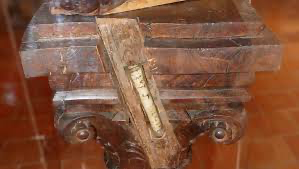
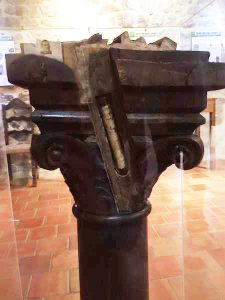
4] Other events that occurred in the year of 1887 include - 5 June: Parish Council Re-Floors the Church of Rennes-le-Château, work undertaken by Saunière Lapolisette, 1 July: Bérenger Saunière reinstated at Rennes-le-Château, 27 July: New Altar (F. D. Monna, Toulouse) donated by Mme Marie Cavailhé, fulfilling a vow she made during a serious illness when living in Rennes-le-Château – a staunch Monarchist belonging to one of the richest families in the department, who in 1874 had published a book of Royalist Poems entitled Fleurs-de-Lys (first poem dedicated to the Comte de Chambord). There is often a mix up between the glass vial found in the wooden baluster which led to the raising of a slab, and the raising of the old altar - commonly accepted that when the old altar was replaced a flagstone usually called ‘La Dalle des Chevaliers’ was discovered. The earliest reference is found in an article by Antoine Fagès dating from 1909: “we notice a tombstone which was discovered at the time the church was paved. It was found lying flat in front of the high-altar. It is made of a very crumbly type of sandstone, and the carving which constitutes its beauty would have disappeared long ago if it had not been found with the design facing downwards.” A reference to the flagstone also appeared in a 1906 article by Elie Tisseyre, who said it was used as a stepping stone on the Calvary, without giving any explanation of its origin. Bérenger Saunière also installed new stained-glass windows (Henri Feur, Bordeaux) in his church costing 1,350 francs – a bill that was paid for in instalments on 30 September 1887, 12 April 1897, 26 April 1899 and 7 January 1900. The beginning of Saunière’s church renovations that were to last for a period of 10 years.
5] It was on 15th February 1891 that the Municipal Council approved Saunière's request to fit out, at his own expense, a square by the church and cemetery, as long he did not construct any roofed building and that a key allowing access was deposited in the Town Hall. Saunière eventually constructed a small building above a water cistern on the site and when the local council did not object, moved his library and office there. Saunière planned to turn the building into a chapel in 1898. Other events in 1891 included - the Dénarnaud family moving into the village Presbytery, including an orphan Julie Maleville (1879-1957) – the foster sister of Marie Dénarnaud. Ceremony 21 June 1891: Statue of Our Lady of Lourdes and the ‘Visigothic’ Pillar installed by Bérenger Saunière at Rennes-le-Château, in the presence of a Lazarist priest from the church of Notre-Dame de Marceille (Lourdes was considered the symbol of the restoration of the Bourbon Monarchy by Père Emmanuel d’Alzon [1810-1880], the founder of the Assumptionist Order). It is commonly believed that the ‘Visigothic’ Pillar dates from at least the Carolingian period, and that it was originally one of two pillars that supported the old church altar. The earliest reference dates from 1906 in an article by Elie Tisseyre, who wrote: “We also noted in another little garden a stone pedestal supporting a Virgin. The pedestal was very old and beautifully worked but had been restored in order to deepen the relief work and in so doing the workman had robbed it of all artistic merit.” The next reference appeared in an article by Antoine Fagès in 1909, who wrote: “to the left of the door of the church, serving as a base for the Virgin of Lourdes, is a pillar which formerly supported the high-altar. According to Abbé Saunières [sic] the high-altar was composed of a large flagstone set into the wall on one side and supported in front by two pillars, one of them coarse and the other just referred to, which appeared to us to date from the same period as the tombstone (‘La Dalle des Chevaliers’). 21 September: From Bérenger Saunière’s Notebook, “letter received from Granes, discovery of a tomb, rain in the evening” 29 September: From Bérenger Saunière’s Notebook, “Saw the curé of Névian – Went to see Gélis – Went to see Carrière, Saw Cros and secret” (“secret” an abbreviation for secrétaire – “Cros” being Abbé Guillaume Cros, 1810-1898, the Vicaire général, with Pierre Pradel the Secrétaire général)
6] It is clear that from 1891 Saunière had the church garden and the cemetery closed to keep snoopers out. In addition, in January 1892, he had the secret room next to the sacristy at the church erected to be able to dig to the possible pilgrim passage that led to the crypt [see reconstruction by Saussez below]. On the other hand, the pilgrim's passage also/and/or led to the cemetery, where Saunière began digging heavily in 1895 in search of a ?second entrance (Saussez 2004). Saussez, an expert on the crypt, was present during the scans of the Eisenman Team in 2001. He noted that ground scans were carried out in places in the church, including in the nave, where there was little chance of finding traces of a crypt. He also saw that the scientists' portable measuring devices were only adjusted to receive ground echoes up to 1.5 m (Saussez 2011). Saussez gave the Eisenman's team the advice to work in the apse of the church where the altar was/is located and where a crypt can normally be found. He also asked them to adjust their equipment to a depth of 5 m (Saussez 2011). It was not until September 2003 that Professor Eisenman showed the results of their ground radar scans at the annual meeting of a geographical association in Wisconsin. However, the measurement results of the scans in the apse, which were performed on the advice of Paul Saussez, were not shown (Saussez 2011). Saussez ...filed a request to obtain a copy of Eisenman's ground radar results. Finally, after 20 months of waiting, Saussez got his hands on them in May 2005. The long wait was worth it because the ground scans showed that there was an underground cavity at a depth of 5 meters under the apse of the church, exactly as Saussez had predicted (Saussez 2011). These soil research results were confirmed by a second independent research team. In April 2008, British businessman Sir Richard Heygate asked the city council of Rennes-le-Château to conduct ground radar research in turn. On May 7, 2008, he received permission and the church floor was completely scanned. Results were again not released and the minutes of the city council meeting were also silent on the matter. Through people involved, Saussez managed to gather information about the research results carried out by Sir Richard Heygate's team. The existence of the cavity under the apse was once again confirmed and a second room was also found under the nave of the church. Both rooms, the Tombeau des Seigneurs and the crypt, also appeared to be connected via a narrow passage. Moreover, an 'indefinite mass' would have been observed in the space below the apse, which could possibly indicate a sarcophagus [?of a saint]. In the same year - October: Bérenger Saunière began renovating the church cemetery 1894. On 12 and 14 March: Inhabitants of the village sent two letters of complaint to the Préfet de l’Aude about Saunière’s work in the cemetery referencing the desecration of graves and destruction of epitaphs on gravestones.
Rennes-le-Château, 12 March 1895
We wish to inform you that, with the agreement of the Municipal Council of Rennes-le-Château, the meeting in the Town Hall at one o’clock on Sunday 10 March, we the electors wish to protest that the decision giving the curé the right to continue work makes no sense and in addition we desire to be freely responsible to tend the graves of our forebears. The curé has no right to remove, raise or relocate any ornaments, crosses or crowns from where we have placed them.
Sarda, Gavignaud, Delmas, Vidal,etc
Rennes-le-Château, 14 March 1895
We are far from satisfied with prevailing conditions in the cemetery. Crosses are removed, as are tombstones, and this said work has nothing to do with repairs nor is there a good reason for it
Baumore,Rousset,Bouteille,etc
The highlighted texts are interesting. First of all the letter of the 12th March suggests that whatever Sauniere was doing in the cemetery, the Municipal Council had given him permission to do so. It made no sense to the complainants and they also wanted to 'be freely responsible to tend the graves of our forebears'. It suggests that they were not allowed to do so. In the second letter of the 14th March, another set of different families from the first complained of tombstones being removed, and that this 'work' has nothing to do with repairs, obviously the reason Sauniere has given for his upturning of various areas in the cemetery.
 The priest built his secret room near to an arch which may have concealed a doorway and steps to the crypt. One can see the crypt entrance was near to the old doorway of the entrance to the church/chapel for the Hautpoul family.
The priest built his secret room near to an arch which may have concealed a doorway and steps to the crypt. One can see the crypt entrance was near to the old doorway of the entrance to the church/chapel for the Hautpoul family.
7] 12 and 14 March: Inhabitants of the village sent two letters of complaint to the Préfet de l’Aude about Saunière’s work in the cemetery as detailed above.
8] This is shown rather vividly by the reconstructions and plans Saussez made as an architect and presented in his DC Tomb of the Lords.
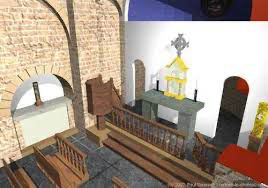
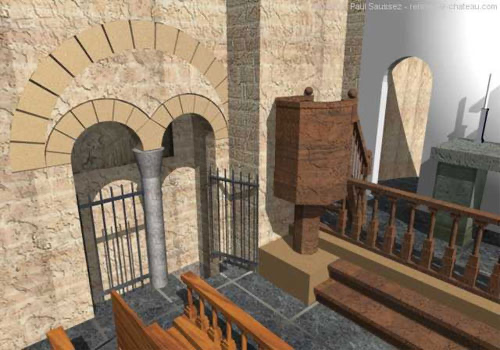
The top illustration shows the old altar to the Virgin as envisioned by Saussez. The bottom is where another entrance to tomb may have been found.
9] In their excellent book L'Héritage de l'abbé Saunière, the couple Antoine Captier and Claire Corbu describe how they came into possession of Saunière's personal papers thanks to their father-in-law Noël Corbu and through the inheritance of Marie Dénarnaud. Between these papers of Saunière the couple Captier-Corbu find an old church register from 1694, which was mainly filled in by priest Vernat, one of Saunière's predecessors. It is currently in the hands of the municipal administration of Rennes-le-Château. The following passage makes it clear why Saunière cherished the old church register in his personal possessions:
"L'an mil sept cents cinq le trente jour de mars est décédée, dans le château de ce lieu, dame Anne Delsol, age d'about septante cinq ans, veuve de messire Marc Antoine Dupuy, sieur de Pauligne, ancien trésorier de France de la généralité de Montpellier... elle a été inhumée le trente et un du dit mois, dans l'église de ce place, au tombeau des Seigneurs qui est auprès du Balustre...
"In the year 1705 died on the thirtieth day of the month of March in the castle of this village, Mrs. Anne Delsol, at about the age of 75, widow of Mr. Marc Antoine Dupuy, Lord of Pauligne, former treasurer of the Montpellier region... she was buried on the thirty-first day of this month, in the church of this place, in the tomb of the Lords which is located near the Baluster..." (Captier & Corbu 1985: 271)"
There is some doubt about the interpretation of the word 'Balustre', because according to several researchers, two places are possible. According to the Captier-Corbu couple, the word 'Balustre' would refer to the wooden pillar that once supported the old wooden pulpit. Not illogical because this wooden pillar is already shrouded in mysteries due to its history; it was during Saunière's restoration and demolition work in 1887 that Antoine Captier's great-grandfather had found a glass phial with a small parchment in a secret recess of this pillar. According to the Captiers, access to the crypt should therefore be found somewhere around the area of the old pulpit (Captier & Corbu 1985).
However, Saussez had a different opinion. Based on old dictionaries from the time of Vernat, he concluded that the word 'Balustre' stood for a 'communion bank', also called a 'balustrade'. Since the pulpit and the communion bench were in fact close to each other, one of the entrances to the Tombeau des Seigneurs must be sought there.
10] There is no doubt that Saunière rediscovered access to the crypt in 1891 during his restoration work. His diary of September 1891 containing the fragment 'Découverte d'un tombeau' speaks volumes about this. Thanks to his notebooks, in which Saunière carefully noted the workers' salaries, we know that on that day he had his workers prepare the installation work of the new pulpit. So it is near the old sermon choir and the 'Balustre' where a possible access staircase to the crypt probably begins. In 2001, Saussez went over the Cholet report together with notary André Gastou, who was present during Cholet's excavations in the church and recorded his finds. Gastou confirmed that Cholet had indeed discovered a staircase under the pulpit that led to the cemetery and also agreed that he had found a stone arch of a possible doorway in the floor of Saunière's secret room in the church. Cholet thought, like Saussez, that there might be a passage under the church from this location. In January 1892, he had the secret room next to the sacristy at the church erected to be able to dig for the possible pilgrim passage that led to the crypt. On the other hand, the pilgrim's passage could also have led to the cemetery, where Saunière began digging heavily in 1895 in search of a possible second entrance (Saussez 2004).
11] The Gate of the Lords - depicted here by Sauusez; 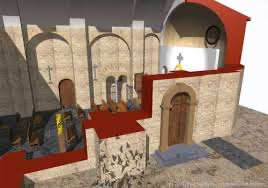
12] This comment by pastor Vernat clearly proves that the local nobles were buried after their death in a burial room under the church, the Tombeau des Seigneurs as the crypt was called. The location of this crypt is even explicitly mentioned by Vernat, namely qui auprès du Balustre [by the Baluster]. The nobility was probably buried in the cemetery in later times because there was simply no more room in the crypt. It is possible for this reason that the crypt was closed. The old church register may be able to bring light on the time when the crypt was closed. Through the church register of 1694, maintained by pastor Vernat, we know that in addition to the lady Anne Delsol, two other nobles were associated with the crypt. The last one mentioned is a certain Henry du Vernet. He died in 1724 and was also buried in the crypt (Mensior 2010). In the next register from 1736 we learn that the next dead nobleman, which we know of, was little Joseph d'Hautpoul. The only son of François d'Hautpoul and Marie de Nègre was only two years old. The church register explicitly states that Joseph was buried in the cemetery (Mensior 2010). Paul Saussez suspects that the sealing of the crypt may also have to do with the death of Joseph d'Hautpoul. He was the last male scion of the Hautpoul family branch from Rennes and with his death the Tombeau des Seigneurs had no more reasons for its existence (Saussez 2011).
Saussez depicted the Tomb of the Lords and the second possible crypt found on archaeological scans;
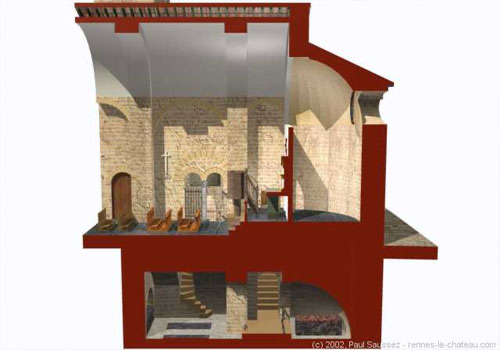

13] There is no doubt that Saunière rediscovered access to the crypt in 1891 during his restoration work. His diary of September 1891 containing the fragment 'Découverte d'un tombeau' speaks volumes about this. Thanks to his notebooks, in which Saunière carefully noted the workers' salaries, we know that on that day he had his workers prepare the installation work of the new pulpit. So it is near the old sermon chair and the 'Balustre' where a possible access staircase to the crypt probably begins.
14] In the contemporary Christian world, the word crypt is used to refer to a tomb under a church that contains relics or tombs. Usually the crypt was located under the apse of the church, just below the altar. In later times, in addition to the crypt, the graves of clergy, nobles or their blood and relatives were also housed. We know the Tomb of the Lords was originally housed under the chapel of the Hautpoul family. One supposes that they built their chapel and tomb in the vicinity of the crypt as the archaeological scans reveal. As we saw there are two types of burial spaces under the church of Rennes-le-Château, which will often both designate with the umbrella term 'crypt'. In the 2010 edition of Parle-moi de Rennes-le-Château, French researcher Patrick Mensior came out with an interesting article. This was an extract from a 19th-century French ecclesiastical code that discussed the conditions for the construction, furniture and decoration of churches according to the canonical laws (Mensior 2010). In the book, a separate chapter was also devoted to the conditions for a crypt in a church. Article 2 in particular is interesting to us and also very explicit: that according to the ecclesiastical laws, there can only be a crypt in a church if there is a grave of a saint. Possibly this statement should also be extended to all kinds of religious objects. In addition, a crypt aims to bring the faithful as close as possible to the body of the saint, so that they can pray in silence there (Mensior 2010). If the church of Rennes-le-Château has a crypt, this means that a saint has been buried. The key question is, of course: "Which saint?" Knowing that Saunière received many misintentions from congregations from the most important Catholic sanctuary of France, namely Lourdes, this can only be an important saint.
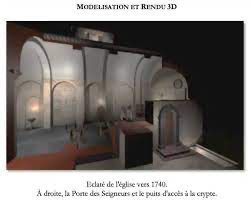
Above, the church as depicted by Saussez in 1740.
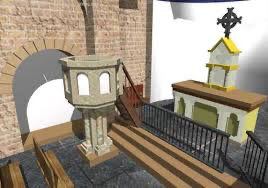
The church interior after the new pulpit has been installed and brought forward.

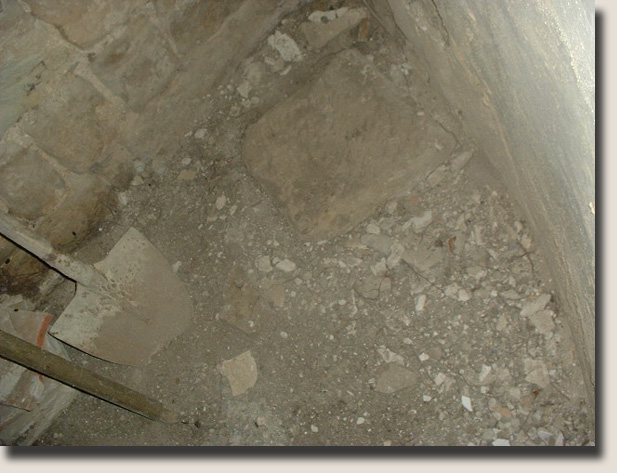
The arch of an access to the crypt visible in Saunières secret room, first discovered by Jacques Cholet in 1959.
(Photo © Saussez 2002).
With thanks to the website of https://www.renneslechateaumysterie.be/crypte.php & https://priory-of-sion.com/rlc/rennes-le-chateau-timeline.html.